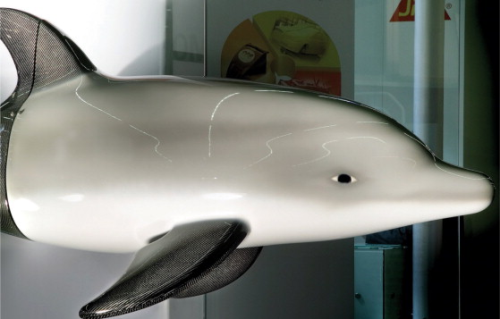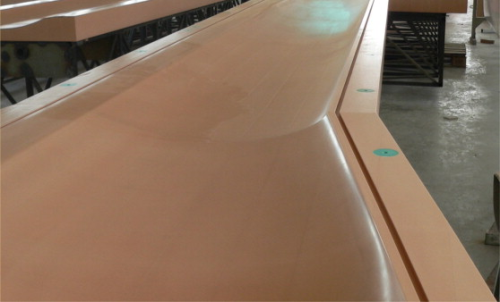

It is a well-known saying that all roads lead to Rome. The same applies to model making. Models can be made directly from model boards or modern paste systems can be used – the method used depends on the application in question.
But a consideration of economics is also essential. If it is a one-off model, lightweight, low cost foam boards with a density of 0.08 kg/dm3 are suitable. Boards such as SikaBlock® M80 can be machined very easily. Despite their low density, an extremely good surface finish is achieved and very little dust is produced during machining. Moreover, there is no unpleasant 'gritty' residue remaining on the surface of the board.
For models for which a substantially higher level of robustness and pressure resistance is required, polyurethane (PUR) model boards with a density from 0.45-0.7 kg/dm3 are recommended. They can be machined quickly and only produce a small amount of dust.
As for all board and most paste materials, with numerically controlled milling machines and modern CAD/CAM techniques, very complex models can be made in a very short time with very high precision.
Boards or paste
Model boards are very suitable for painting. Surfaces can be sealed with a standard two-component spray filler, for example, SikaBlock M450 (0.45 kg/dm3). For sealing a master model made of SikaBlock M610 (0.7 kg/dm3), a two-component PUR lacquer can be used. As a result the pores are all sealed completely. After a small amount of finishing work with fine abrasive paper, a very smooth, high-quality surface is produced.
When it is important to create a permanently sealed surface without any difficult-to-hide adhesive joints in your model, paste systems are an attractive alternative. Until recently, wooden materials were employed in the main area of use for paste systems, namely large model making. The use of timber caused many problems for the user as a result of characteristics such as shrinkage, swelling, deformation, cracks in the structure or enormous quality fluctuations – all disadvantageous phenomena which are considerably diminished if paste systems are used.
Many companies are already using paste systems for models and moulds for rotor blades of wind turbine machines or for the hulls of boats and yachts. When a paste system such as Biresin M72 is used it creates an ideal milling medium, enabling the user to reduce the work by between 50% and 80% between creation of the design to completion of the model, compared to traditional methods which involve creation of a master model. The seamless surface ensures a high level of vacuum integrity, resulting in a very high level of process safety for the second step, namely making of the fibre reinforced plastic (FRP) mould using the vacuum infusion method.
For the substructure of the paste systems, lightweight foam boards are inexpensive and highly suitable. To improve adhesion between the paste system and the substructure an intermediate layer of glass fabric (200 g/m2 approx.) is laminated onto the foam with epoxy resin. Standard laminating resins can be used for this.
Mould making
For mould making, there are also many methods and systems available to the user.
The shape of the moulds and the selection of materials always depends on the requirements and the calculated quantity to be produced. In the case of composite prototypes and small composite series, block materials are often preferred for making moulds. Manufacturers of wind turbines or lightweight aircraft have produced quantities of more than 100 components in moulds made with SikaBlock M610. Such PUR model boards are optimal for this purpose because of their good price/performance ratio and the reasons named above.
When larger dimensions for the base of the mould are involved (>1 m2), the use of a mould substructure is recommended. These are usually frames made of metal tubes, welded together and with the mould segments bedded on top. For large moulds and a corresponding temperature difference (TD), the mould segments are no longer fixed in place but float on the substructure to reduce the risk of distortion. SikaBlock M610 is highly resistant to solvents and this facilitates cleaning and considerably increases resistance to the most varied kinds of release agent, thereby preserving mould surface quality.
The lighter boards are often used as mould material for laminating tools, including the construction of aerofoils for glider aircraft. For example, the German aircraft builder Hansjörg Streifeneder Glasfaser-Flugzeug-Service GmbH recently made a set of moulds (laminating tools) from SikaBlock M450 for a builder of glider aircraft. For the initial small quantity made by the hand lay-up method with vacuum consolidation, the primary advantage is that these laminating tools can be made in a short time and also at very low cost.
The low density of this material enables easy handling of the moulds during production of the composite components. These tools consist of two mould halves and frequently have to be opened and closed for closed for further steps in the process after the individual parts of the shell have been made. Thanks to the low weight of such a polyurethane mould, there are no excessive demands on the handling devices such as cranes or mobile lifting gear. However, the lifetime of a mould made from this lightweight polyurethane model board is limited to a few casts and the somewhat greater amount of work involved in sealing (a result of the higher porosity compared to model boards with a higher density) must be taken into account. In order to prevent damage to edges and accommodate location pins and holes, higher strength material is used in these areas as inserts.
A special grade of cast, unfilled PUR tooling board is recommended for laminating tools that have to be highly resistant to pressure and abrasion, and must also display enormous edge stability but nevertheless have very good milling qualities. Because of its high quality surface this has only to be treated with the corresponding release waxes, meaning it can be used with very little delay in the production process. SikaBlock M940 (density 1.2 kg/dm3) in particular yields a very good result after polishing, so that high-gloss and very smooth surfaces can be achieved speedily and efficiently.
For all model and tooling boards, suitable adhesive and filler systems are available.
When it is important to make heat-resistant moulds with very low thermal expansion, the focus should be on classic, conventional mould making. This type of mould making is possible with the most varied kinds of fibre materials. However, glass and carbon fabric are mostly used. The choice of epoxy-based gel-coats and laminating system is determined according to the purpose for which the tool is to be used. A decision can then be made as to whether the mould is to be resistant to chemicals or high temperatures, or whether the surface is to be extremely resistant to abrasion, and then the correct materials selected.
Composite parts manufacture
As a result of their outstanding mechanical properties, epoxy resin systems are nowadays the most frequent choice for composite parts. When composite parts are being made, a distinction must be made between the processes available: infusion or resin transfer moulding (RTM), and wet lay-up.
Infusion or RTM
For infusion and RTM resin systems, the viscosities of the resin/hardener mixtures are around 200-300 mPas. This ensures sufficiently quick impregnation of the fibre bundle. The pot lives in the case of epoxy systems vary from less than 30 minutes to more than 5 hours, depending on the hardener selected.
Many composite systems such as Biresin CR80 also have the advantage of identical mixing ratios within the systems. This enables simple mixing for the adjustment of individual pot times.
The normal processing temperature for cold-curing epoxy systems is 20-25°C. However, this temperature cannot always be guaranteed, especially in the area of container and ship building. Because of the size of the end product, suitable factory halls that can maintain a suitable temperature are something of a rarity and to heat up these buildings would result in enormous energy costs. Biresin CR81 was especially developed for such cases. Its very low mixing viscosity enables it to be worked without any problems at a temperature of approximately 15 °C.
Epoxy systems with heat and chemical resistance, low shrinkage and exceptional adhesion are used to make structural components and moulds, and are used in a diverse range of other industrial applications. To demonstrate the possibilities of epoxy systems in especially complex component geometries the dolphin shown in the picture above was created. It required a minimum of effort and was possible to complete at a very low cost. The fact that these materials are very easy to process to make any kind of free-form contours means that they have a great advantage over other materials which involve more work and energy for the moulding process. This exhibit was produced for a trade fair using carbon fibre fabric, low-viscosity Biresin CR80 and the infusion method.
Depending on the intended use of the parts or moulds being made, different levels of temperature resistance (e.g. 80°C and 120°C) can be achieved with different resins and under different hardening conditions (curing schedules).
Wet lay-up method
In order to ensure that the composite resin remains in the fibre structure and does not drain off after simple and rapid impregnation during the wet lay-up procedure, wet lay-up systems require good wetting characteristics and correspondingly balanced viscosity levels. In the case of Biresin CR82 and Biresin CR122, the above requirements for a wet lay-up system have been implemented successfully.
These epoxy resin systems are therefore suitable for the impregnation of vertical laminates such as those used for making boat hulls. The worker does not have to fear that so-called resin lakes form due to resin draining during the initial moments of the hardening process, or that correct fibre wetting in other areas of the laminate is not adequate. The special feature of the Biresin CR122 high-temperature system is that it easy to remove from the mould at room temperature after hardening at room temperature. The laminate component can thus be removed from the mould without suffering any damage and without any additional heat treatment. The so-called stress whitening caused by bending in under-cured laminates is avoided.
Epoxy systems with these viscosities can also be used for pultrusion, filament winding and mechanical impregnation of fibres and fabrics.
Epoxy systems are also advantageous in respect of reducing workplace pollution. Nowadays, toxic basic materials, volatile and strong smelling materials such as styrene (polyester systems) for example are usually avoided when composite systems are being developed. The health risk to the worker is thus reduced considerably.
